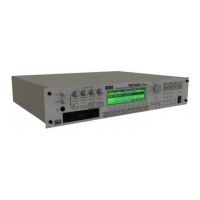38
Assigning a name (Rename)
You can modify the name of an edited program, combi-
nation, multi, drum kit, user arpeggio pattern, multi-
sample or sample etc.
You can also modify the category names for programs
and combinations.
These renaming operations can be performed in the
following pages.
1 Open the text dialog box.
Refer to the above table for the relevant page.
In the utility commands, press “Name” (the [F5]
key) in the dialog box that appears.
In GLOBAL 4.1, select “TEXT” (press the [F5] key).
For example if you wish to input the text shown in
the screen shown above, you would use the follow-
ing procedure.
2 Press the [F1] (“Clear”) key.
All text of the text box will be erased.
3 Input “A”
Use the [VALUE] dial, the [INC], [DEC] keys, or
[ ], [ ], [ ], [ ] keys to select “A.”
Press the [ENTER] key or [F6] (“ ”) key. The cursor
will move.
4 Input “.”
Use the [VALUE] dial, the [INC], [DEC] keys, or
[ ], [ ], [ ], [ ] keys to select “.”
Press the [ENTER] key or [F6] (“ ”) key. The cursor
will move.
Repeat this step to input all the characters.
5 Press the [F8] (“OK”) key.
If you selected “Name” in the dialog box of step 1
to access the text dialog box, you will return to the
previous dialog box. Press the [F8] (“OK”) key in
that dialog box to execute the Rename operation.
If you selected “TEXT” in step 1 to access the text
dialog box, the Rename operation will be executed.
The function buttons will have the following functions.
Clear: Erase all text.
Del (Delete): Delete the character at the cursor loca-
tion.
Ins (Insert): Insert a space at the cursor location.
Cap. (Capital): Switch between uppercase and
lowercase letters.
: Move the cursor to the left.
: Move the cursor to the right.
The following input operations can also be
performed.
“0”–“9,” “–,” and “.” can be input using the numeric
keys. When you input these, the cursor will advance
automatically.
To input successive spaces (blanks), press the
[ENTER] key at the last-selected text.
About the Edit Buffer
When you select a program or combination in PROG
1.1: Play and COMBI 1.1: Play, the program or combi-
nation data is called into the “edit buffer.”
When you modify the parameters in 1.1: Play or in the
edit pages 2.1–7.3 of Program mode or Combination
mode, the changes you make will affect the data in the
edit buffer.
If you wish to save this modified data into internal
memory, you must perform the Write operation.
When you perform the Write operation, the data in the
edit buffer is written to the specified program number
or combination number of the specified bank.
If you select another program or combination without
writing, the data of the newly selected program or
combination will be called into the edit buffer, and
your changes will be lost.
When you press the [COMPARE] key in the edit
pages 2.1–7.3 of Program mode or Combination
mode, the data from memory (i.e., the contents
that were written into memory) will be tempo-
rarily called into the edit buffer. This allows you to
compare the settings you are editing with the orig-
inal un-edited settings.
Programs PROG 1.1...7.3 Utility: Write Program
Combinations COMBI 1.1...7.3 Utility: Write Combination
Multis MULTI 1.1...4.4, 6.1 Utility: Rename Multi
Tracks MULTI 1.1, 5.1 Utility: Rename Track
Patterns MULTI 5.1 Utility: Rename Pattern
Multisamples SMPL 1.1...4.1, 5.2 Utility: Rename MS
Samples SMPL 1.1...4.1, 5.2 Utility: Rename SMPL
Drum kits GLOBAL 5.1 Utility: Rename Drum Kit
User arpeggio patterns GLOBAL 6.1 Utility: Rename Arpeggio Pattern
Program categories GLOBAL 4.1: TEXT
Combination categories GLOBAL 4.1: TEXT
File DISK, Save Utility: Save All...Export Smpl AIF/
WAV
Edit Buffer
Write
Select
Internal Memory
Edit
Program
Bank INT-A 0...127
Program
Bank EXB-A 0...127
Combination
Bank INT-A 0...127
Combination
Bank EXB-A 0...127
When you write, the program or
combination settings will be
saved in internal memory.
When you select a program or
combination, its data is called from
internal memory into the edit buffer.
Editing applies to the data in the edit
buffer. Programs or combinations will
play according to the data in the edit
buffer.

